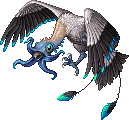Viewing VJqHX

Father: Unknown
Unknown Pedigree
Hardiness: 11
Appearance: 2
Emerged: 1:04 30.10.2021
Matured: 9:29 31.10.2021
With their bald heads and squishy tendrils, Malvolva Kapos are a sight different from their avian cousins. The appendages on their face are quite dexterous and allow the birds to bring food closer to their beaks while eating. Malvolva Kapos are most often found circling in the sky or huddled around carrion, their favorite food. Family groups of up to twelve birds can strip a Kosmira Girafo’s carcass of soft tissue in about an hour and will often spend the time afterward grooming one another with their tendrils. Their sense of smell is incredible, allowing them to track food from up to three kilometers away, and they tend to prefer older carcasses. Malvolva Kapo courtship rituals consist of males splaying their wings and wiggling their tendrils to attract females. If a female is interested, she will match the rhythm of his tendrils with hers, and they will come together until their tendrils are intertwined. Once this display is finished, the pair bond for life. While a Malvolva Kapo will generally pick a mate with the same color markings and bioluminescence as their own, this does not necessarily exclude individuals with different colors. In captivity, Kapos will mate with whatever is available, so long as the courting display is acceptable.
The creatures that dwell in this rather desolate world still display some diversity in appearance, eating habits, and social behavior. Whether they have fur or feathers, skin or scales, their unique genetic makeup allows for a variety of colors and markings within each species. Despite limitations in food sources, herbivores, omnivores, and carnivores are all present in the food chain, and each species requires specialized care within a laboratory. Although the artificial setting of housing units and breeding pods precludes most opportunities to study true interspecific behavior, the interactions within and between species has been studied extensively in the wilderness by scientists daring enough to venture beyond the outpost’s walls.
